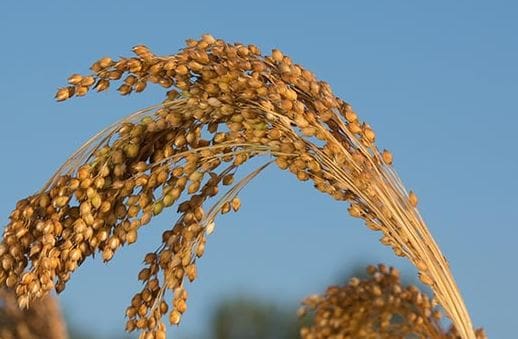THE age-old summer cereal, millet, is staging a resurgence as growers look beyond its potential as a grain or fodder option to its increasingly important benefit as a cover crop to help in the fight against herbicide-resistant weeds.
 While Queensland’s Darling Downs remains the main millet growing area in Australia, the high prices of the past season have tempted growers further afield to include the crop in their rotations, with more millet now being grown in New South Wales and Victoria, and some in Western Australia.
While Queensland’s Darling Downs remains the main millet growing area in Australia, the high prices of the past season have tempted growers further afield to include the crop in their rotations, with more millet now being grown in New South Wales and Victoria, and some in Western Australia.
Deacon Seeds general manager, Mark Schmidt, Dalby, said the size of the millet crop each year was normally around the 20,000 to 30,000 tonnes, but this year because of the hot, dry summer production fell to around 8000 to 10,000t.
The shortfall meant prices rose dramatically as end-users competed for the limited supplies.
“The growers who ended up harvesting millet this year benefited from the high prices. At harvest time it started around $600/tonne and currently it is up around $1300/t to $1350/t,” he said.
“They are really high prices. Most growers would have preferred to get a nice average price of $800/t, but grow seven times the yield. But it didn’t end up that way.
“The growers with a small crop benefited from the high prices, but overall it will probably do short term damage to the industry because some of the buyers have gone out of the market because of the high prices.”
Mr Schmidt said this coming season, if there was widespread rain in September at the start of the sowing period, there was likely to be a substantial millet crop go in the ground, both for grain production and for hay.
But there would also be producers tapping into the crop’s potential as a cover crop for controlling weeds.
Australian Herbicide Resistance Initiative northern extension agronomist, Paul McIntosh, said that was one of the key reasons millet was making a comeback.
“Millet has really been a forgotten crop. It was grown in the old days just for cattle feed. These days we are looking at a range of reasons to grow millet,” he said.
“Apart from getting a good grain crop and having the ability to make hay from it, it is also useful in a cover crop situation.
“We are looking at it as a cover crop to under-smother the weeds that have herbicide resistance and are giving us all sorts of problems.
“Millet is a perfect crop for that: narrow row spacing, plenty of plants per square metre, early growth, active prolific growth which competes with the weeds.”
Mr McIntosh said while most summer crops were grown on 50-centimetre or one-metre row spacings, millet was generally grown on 15cm to 25cm row spacings which helped smother weeds and improved the infiltration of moisture into the soil profile.
He said there was a growing range of difficult or resistant weeds farmers were trying to control.
“There is Feathertop Rhodes grass which has become a real problem. One plant can produce 100,000 seeds. We know that crop competition from sorghum and mungbeans can reduce the number of seeds it produces if we narrow the row spacings and create plant competition. So, we expect an even better result with millet,” he said.
“There are no chemicals we can use in millet for grasses, so we have to rely on the millet from a competitive angle to get on top of the weeds like Feathertop Rhodes grass, barnyard grass and urochloa (Liverseed grass).
“Broadleaf weeds, of course, are a different story. Narrow row spacings will certainly help with sowthistle and fleabane, but you can also use some chemical in the millet crop to give more of a hit on the broadleaf weeds.
“So, millet gives us a lot of advantages without putting at risk the suite of herbicides we are trying to protect and maintain.”
Mr McIntosh said millet had the ability to increase the infiltration of moisture into the ground.
“We know that wheat and barley are the kings of fallows, but for summer we haven’t really got a king of fallows. But we have with millet,” he said.
“Water infiltration is a massive thing during the fallow period on the black soils when we like to build up soil moisture to provide security for the next crop.
“Millet’s root architecture below the ground and the narrow row spacing help infiltration.
“With sorghum on one-metre rows there are only a couple of stalks and the rest of the area is bare. The temperature gets up, the rainfall infiltration is poor and everything is against the capacity to refill the profile every time we get big falls of rain. Millet will hold onto that rain and put it into the ground.”
Mr McIntosh said another little-known benefit of millet was that it helped encourage the activity of soil biota and microbes.
“Millet has a handy root system that might proliferate the good guys below the surface to the benefit of the next crop,” he said.


G’day. With a farm in central Eyre Peninsula planning to sow lucerne into a shirohie millet pasture do you think the millet would outcompete lucerne (winter active style GT160 variety) growth establishment? The plan would be after summer to slash what the sheep leave behind then sow lucerne with narrow row disk into an early winter break. Does anyone one see an issue with this plan?
Alex, thanks for your experimentation here with millet and lucerne. To get knowledge of other people’s experiences try one of the EP grower groups. You could also contact the lucerne seed company which, if it is GT160, would be located at Wingfield north of Adelaide, S&W Seed whose phone is 8445 1111. Best of luck and let us know how it goes. -Ed.
Has anybody grown maximillet for beef forage? I would like to know how it would compare with rebound millet!
Looking at sowing 60ha millet in WA on light sandy loam. A lot of moisture available.
A few questions:
What is the earliest we can sow?
Recommended row spacings – we have 10″
Recommended seed rate & variety?
Starter fertilizer & N requirements?
What is the growing season length & crop stage timing?
My mobile is 0408299198
Regards, Gregor
Just interested to hear if anybody is growing or interested in growing finger millet varieties. There is an O/seas market for koracana variety.
Hello Chris
what conditions suit Koracana?
I am a BD certified organic producer in central tablelands of nsw and looking to plant 60 acres of millet as part of my summer programme.
are you looking for producer s to buy product from ?